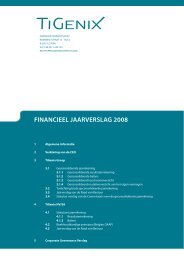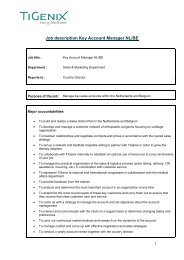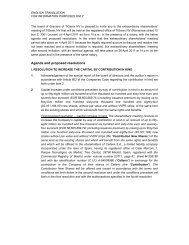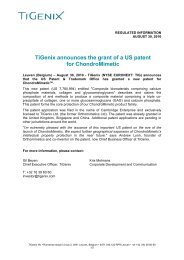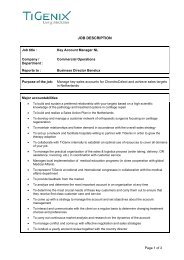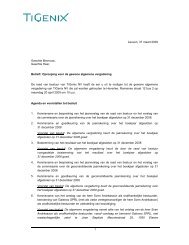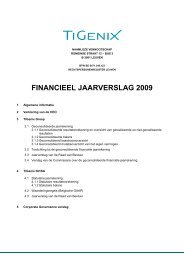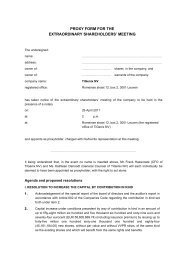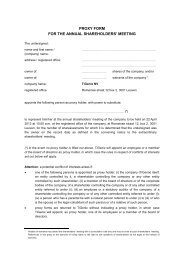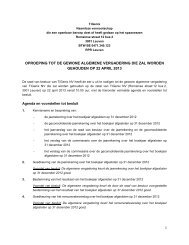ANNUAL REPORT 2012 - TiGenix
ANNUAL REPORT 2012 - TiGenix
ANNUAL REPORT 2012 - TiGenix
You also want an ePaper? Increase the reach of your titles
YUMPU automatically turns print PDFs into web optimized ePapers that Google loves.
- It is estimated that approximately 20-40 %<br />
of RA patients do not have an adequate<br />
response to treatment with anti-TNF agents.<br />
6.5.2.3. Cx621<br />
The product Cx621 completed a clinical<br />
development Phase I safety and feasibility<br />
study in <strong>2012</strong>. The product is intended for the<br />
treatment of inflammatory and autoimmune<br />
diseases.<br />
Autoimmune diseases are a group of more<br />
than 100 conditions that are caused by<br />
disruptions to immune homeostasis. This<br />
results in the targeting of autoantigens by the<br />
immune system, i.e. the body attacks itself.<br />
Although the causes of autoimmune diseases<br />
are still being investigated, recognized<br />
risk factors include genetic predisposition,<br />
lifestyle factors, environmental factors and<br />
gender. The characteristic immediate result<br />
of an autoimmune condition is inflammation.<br />
This is the result of the aggregation of cells<br />
and molecules associated with the immune<br />
pathways in a tissue. While inflammation<br />
is a critical component of healing<br />
processes, uncontrolled and inappropriate<br />
inflammatory processes can lead to serious<br />
complications such as tissue degeneration.<br />
As such autoimmune diseases are often<br />
chronic and debilitating conditions that<br />
place a huge burden on not only individuals<br />
but also their health care providers.<br />
Autoimmune diseases have for many<br />
years been treated with anti-inflammatory<br />
drugs such as corticosteroids, NSAIDs and<br />
cytotoxics. Although some success has<br />
been achieved by use of these therapies, in<br />
general these benefits are limited. In recent<br />
years, biologics have been developed in<br />
order to meet the need for more specific<br />
treatments for a range of autoimmune<br />
diseases and as such command premium<br />
pricing. Nevertheless, there are also major<br />
drawbacks for this relatively new therapeutic<br />
group. First of all, a significant portion of<br />
treated patients (>20 %) do not have an<br />
adequate response. Secondly, biologics<br />
have serious safety concerns regarding<br />
long term use : non tolerability, recurrent<br />
secondary infections, risk of cardiotoxicity,<br />
etc. And finally, as the efficacy is limited in<br />
time, patients will have to switch to other<br />
biologics.<br />
Despite the wide variety of therapeutic<br />
options there is thus a very high medical<br />
need for innovative therapies that are<br />
effective and safe and have the potential<br />
to become a new treatment paradigm.<br />
Adipose derived stem cell therapy, which<br />
combines anti-inflammatory and immune<br />
modulatory mechanisms of action,<br />
represents a promising alternative therapy.<br />
6.5.3. Manufacturing and logistics<br />
of eASC products<br />
Today, the autoimmune disease market<br />
represents a EUR 40 billion market<br />
opportunity based on sales of currently<br />
marketed products in the eight major<br />
diseases : Rheumatoid Arthritis (RA), Multiple<br />
Sclerosis (MS), Systemic Sclerosis (SS), Lupus,<br />
Psoriasis, Juvenile Idiopathic Arthritis (JIA),<br />
Ankylosing Spondilytis (AS), and Inflammatory<br />
Bowel Disease (IBD)/Crohn’s Disease (CD).<br />
<strong>TiGenix</strong>’s eASC development stage products<br />
are considered medicinal products<br />
(pursuant to Spanish Order SCO/3461/2003)<br />
and therefore must be manufactured in<br />
compliance with cGMP in an authorized<br />
pharmaceutical establishment. This<br />
also applies to the medicinal products<br />
manufactured for use in clinical trials.<br />
68 <strong>TiGenix</strong> I annual report <strong>2012</strong>



